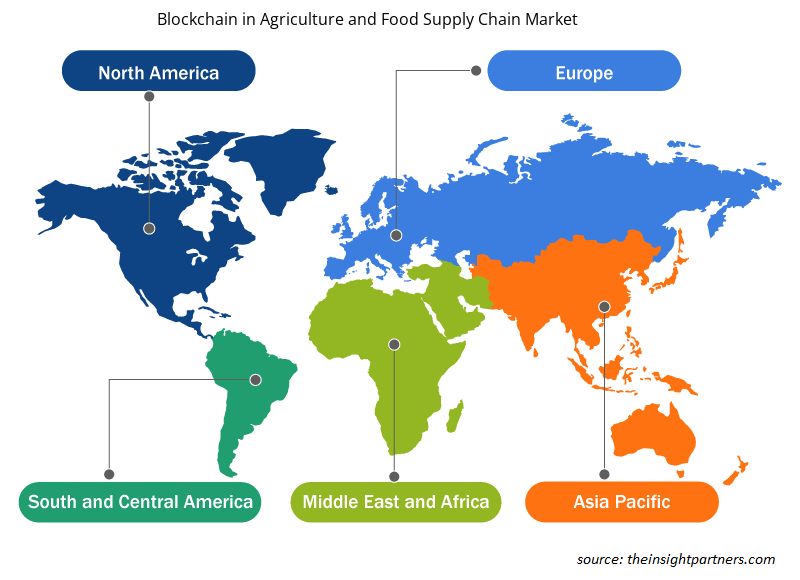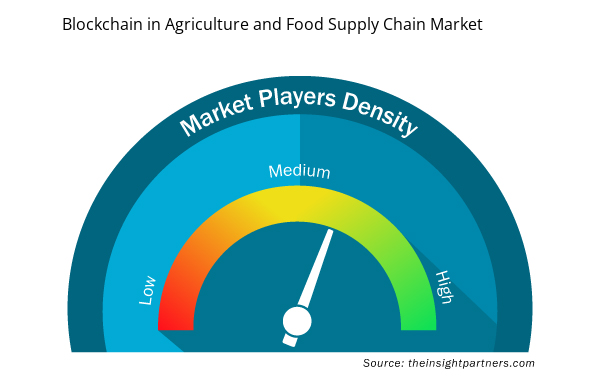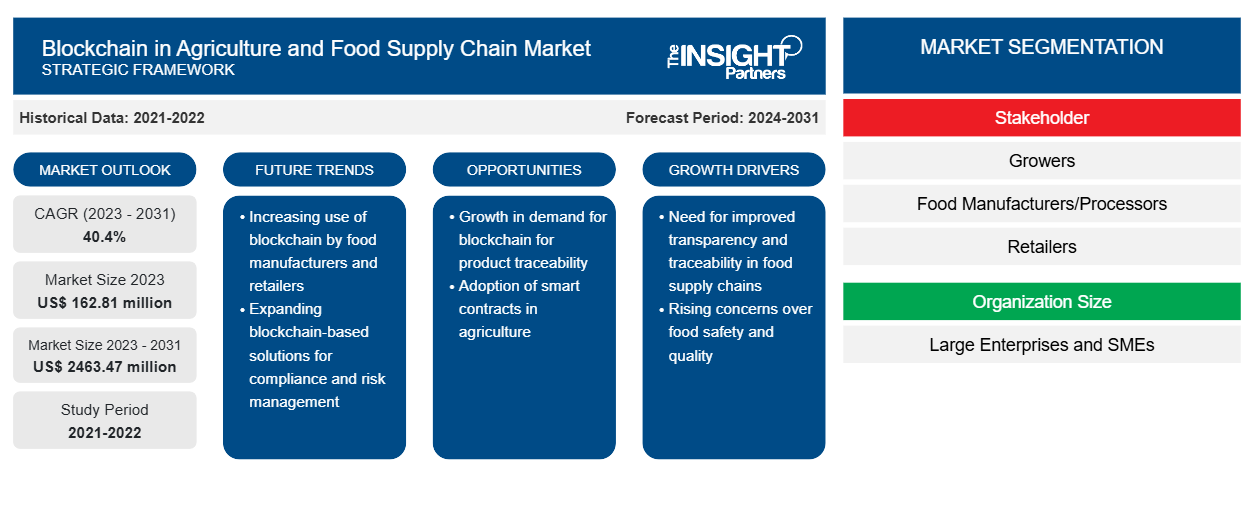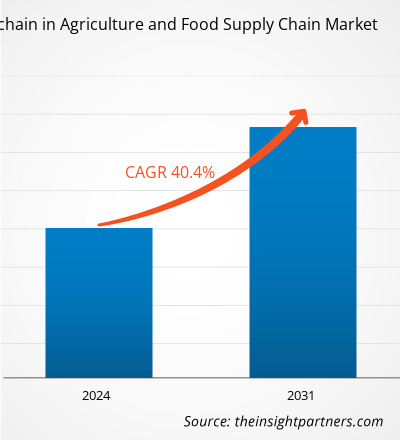من المتوقع أن ينمو حجم blockchain في سوق سلسلة توريد الزراعة والأغذية من 162.81 مليون دولار أمريكي في عام 2023 إلى 2463.47 مليون دولار أمريكي بحلول عام 2031 ؛ ومن المتوقع أن يتوسع بمعدل نمو سنوي مركب قدره 40.4٪ من عام 2023 إلى عام 2031. إن التتبع المحسن والشفافية، والطلب من المستهلكين على الشفافية، وكفاءة سلسلة التوريد، ومنع الغش والتلوث الغذائي، والحد من هدر الغذاء، تعمل على تغذية نمو blockchain في سوق سلسلة توريد الزراعة والأغذية.
تحليل سوق تقنية البلوك تشين في الزراعة وسلسلة توريد الأغذية
عزز الطلب المتزايد على تقنية البلوك تشين من الشركات الصغيرة والمتوسطة الحجم حضور البلوك تشين في سوق سلسلة توريد الزراعة والأغذية. علاوة على ذلك، من المتوقع أن يؤدي دمج أجهزة إنترنت الأشياء (IoT) إلى تسريع توسع الأسواق خلال الفترة المتوقعة. علاوة على ذلك، تتخذ الشركات الكبرى مبادرات مختلفة لتوسيع محفظتها وحضورها العالمي والذي أصبح اتجاهًا رئيسيًا للبلوك تشين في سوق سلسلة توريد الزراعة والأغذية.
نظرة عامة على سوق تقنية البلوك تشين في الزراعة وسلسلة توريد الأغذية
- أصبحت الشركات المرتبطة بالزراعة مهتمة بشكل متزايد بتكنولوجيا البلوك تشين. وتتفوق الشركات تدريجيًا من خلال عرض كيفية إنشاء المعرفة المتعلقة بسلسلة التوريد، وتقليل الاختناقات في المعاملات من خلال تحسين كفاءة إدارة البيانات الناتجة عن تطوير التكنولوجيا.
- يسلط قطاع الزراعة الضوء على مدى أهمية التكنولوجيا في تقليل تكاليف المعاملات وتبسيط الخدمات اللوجستية وتعزيز إمكانية التتبع وتحسين إجراءات سلامة الأغذية.
- تمثل تقنية Blockchain فرصة مثيرة لتحسين الشفافية وتقليل المقاومة وتعزيز الكفاءة المتعلقة بالمعاملات في سلاسل التوريد الزراعية العالمية.
قم بتخصيص هذا التقرير ليناسب متطلباتك
ستحصل على تخصيص لأي تقرير - مجانًا - بما في ذلك أجزاء من هذا التقرير، أو تحليل على مستوى الدولة، وحزمة بيانات Excel، بالإضافة إلى الاستفادة من العروض والخصومات الرائعة للشركات الناشئة والجامعات
- احصل على أهم اتجاهات السوق الرئيسية لهذا التقرير.ستتضمن هذه العينة المجانية تحليلاً للبيانات، بدءًا من اتجاهات السوق وحتى التقديرات والتوقعات.
فرص سوق البلوك تشين في الزراعة وسلسلة توريد الأغذية
دمج أجهزة إنترنت الأشياء (IoT) لخلق فرصة لنمو سوق البلوكشين في الزراعة وسلسلة توريد الأغذية
- يؤدي دمج أجهزة إنترنت الأشياء (IoT) مع تقنية blockchain للزراعة وسلاسل توريد الأغذية إلى تحسين جمع البيانات والمراقبة في الوقت الفعلي، مما يؤدي إلى زيادة الشفافية وإمكانية التتبع ومراقبة الجودة، فضلاً عن زيادة كفاءة سلسلة التوريد.
- تعمل الشركات على تأمين البيانات في أجهزة إنترنت الأشياء باستخدام تقنية البلوك تشين. يمكن للأجهزة الذكية تبادل البيانات وإجراء أنشطة مالية أخرى بطريقة قابلة للتطوير وآمنة وموثوقة عندما يتم استخدام تقنية البلوك تشين جنبًا إلى جنب مع أجهزة إنترنت الأشياء.
- بالإضافة إلى ذلك، تعمل تقنية blockchain جنبًا إلى جنب مع إنترنت الأشياء على تمكين المؤسسات من تبادل البيانات والوصول إليها دون الحاجة إلى التحكم والإدارة المركزية، مما يعزز نمو blockchain في سوق الزراعة وسلسلة توريد الأغذية.
تقرير تحليلي لتجزئة سوق سلسلة توريد الأغذية والزراعة باستخدام تقنية البلوك تشين
- بناءً على حجم المنظمة، يتم تقسيم سوق سلسلة توريد الأغذية والبلوك تشين إلى شركات كبيرة وصغيرة الحجم. ومن المتوقع أن تحظى شريحة الشركات الكبيرة بحصة كبيرة في سوق سلسلة توريد الأغذية والبلوك تشين في الزراعة في عام 2023.
- تعمل المنظمات الأكبر بشكل مستمر على الاستثمار في التقنيات المتقدمة مثل blockchain لتعزيز سلسلة توريد الزراعة والأغذية الخاصة بها، مما يغذي نمو هذا القطاع في السوق.
- في حين تعمل الشركات الصغيرة والمتوسطة أيضًا على اعتماد تقنية blockchain لأنها تساعدها على تتبع وإدارة حبوبها أثناء تحركها عبر سلسلة القيمة، مما يدفع نمو السوق بشكل أكبر في الفترة المتوقعة.
تحليل حصة سوق سلسلة توريد الأغذية والزراعة حسب المنطقة الجغرافية
ينقسم نطاق البلوك تشين في سوق الزراعة وسلسلة توريد الأغذية بشكل أساسي إلى خمس مناطق - أمريكا الشمالية وأوروبا ومنطقة آسيا والمحيط الهادئ والشرق الأوسط وأفريقيا وأمريكا الجنوبية. تشهد أمريكا الشمالية نموًا سريعًا ومن المتوقع أن تحتفظ بحصة كبيرة في سوق البلوك تشين في الزراعة وسلسلة توريد الأغذية. تبنت أمريكا الشمالية التكنولوجيا الحديثة بمعدل أسرع بكثير من المناطق الأخرى لإدارة الزراعة وسلسلة توريد الأغذية، مما أدى إلى أكبر حصة في السوق. علاوة على ذلك، تعد الولايات المتحدة وكندا من أكثر دول المنطقة استقرارًا اقتصاديًا، حيث تمثلان جزءًا كبيرًا من السوق.
رؤى إقليمية حول تقنية البلوك تشين في سوق الزراعة وسلسلة توريد الأغذية
لقد قام المحللون في Insight Partners بشرح الاتجاهات والعوامل الإقليمية المؤثرة على سوق سلسلة توريد الأغذية والزراعة خلال فترة التوقعات بشكل شامل. يناقش هذا القسم أيضًا قطاعات سوق سلسلة توريد الأغذية والزراعة والجغرافيا في أمريكا الشمالية وأوروبا ومنطقة آسيا والمحيط الهادئ والشرق الأوسط وأفريقيا وأمريكا الجنوبية والوسطى.

- احصل على البيانات الإقليمية المحددة لسلسلة توريد البلوكشين في السوق الزراعية والغذائية
نطاق تقرير سوق سلسلة توريد الأغذية والزراعة باستخدام تقنية البلوك تشين
| سمة التقرير | تفاصيل |
|---|---|
| حجم السوق في عام 2023 | 162.81 مليون دولار أمريكي |
| حجم السوق بحلول عام 2031 | 2463.47 مليون دولار أمريكي |
| معدل النمو السنوي المركب العالمي (2023 - 2031) | 40.4% |
| البيانات التاريخية | 2021-2022 |
| فترة التنبؤ | 2024-2031 |
| القطاعات المغطاة | حسب أصحاب المصلحة
|
| المناطق والدول المغطاة | أمريكا الشمالية
|
| قادة السوق وملفات تعريف الشركات الرئيسية |
|
كثافة اللاعبين في سوق سلسلة توريد الأغذية والزراعة: فهم تأثيرها على ديناميكيات الأعمال
يشهد سوق سلسلة توريد الأغذية والزراعة نموًا سريعًا، مدفوعًا بالطلب المتزايد من المستخدم النهائي بسبب عوامل مثل تفضيلات المستهلكين المتطورة والتقدم التكنولوجي والوعي الأكبر بفوائد المنتج. ومع ارتفاع الطلب، تعمل الشركات على توسيع عروضها والابتكار لتلبية احتياجات المستهلكين والاستفادة من الاتجاهات الناشئة، مما يؤدي إلى زيادة نمو السوق.
تشير كثافة اللاعبين في السوق إلى توزيع الشركات أو المؤسسات العاملة في سوق أو صناعة معينة. وهي تشير إلى عدد المنافسين (اللاعبين في السوق) الموجودين في مساحة سوق معينة نسبة إلى حجمها أو قيمتها السوقية الإجمالية.
الشركات الرئيسية العاملة في مجال البلوكشين في سوق سلسلة توريد الزراعة والأغذية هي:
- آي بي إم
- مايكروسوفت
- شركة تي اي فود الدولية المحدودة
- أمبروسوس
- شبكة ACR
- ساب اس اي
إخلاء المسؤولية : الشركات المذكورة أعلاه ليست مرتبة بأي ترتيب معين.

- احصل على نظرة عامة على أهم اللاعبين الرئيسيين في سوق سلسلة توريد الأغذية والزراعة في تقنية البلوك تشين
"تحليل سوق تقنية البلوك تشين في الزراعة وسلسلة توريد الأغذية"تم تنفيذه على أساس أصحاب المصلحة وحجم المنظمة والتطبيق والجغرافيا. على أساس أصحاب المصلحة، يتم تقسيم السوق إلى مزارعين ومصنعي/معالجي أغذية وتجار التجزئة. بناءً على حجم المنظمة، يتم تقسيم السوق إلى شركات كبيرة وصغيرة الحجم. بناءً على التطبيق، يتم تقسيم سوق سلسلة توريد الأغذية والبلوك تشين في الزراعة إلى إمكانية تتبع المنتج والدفع والتسوية والعقود الذكية وإدارة مخاطر الحوكمة والامتثال. بناءً على الجغرافيا، يتم تقسيم السوق إلى أمريكا الشمالية وأوروبا ومنطقة آسيا والمحيط الهادئ والشرق الأوسط وأفريقيا وأمريكا الجنوبية.
أخبار وتطورات حديثة حول تقنية البلوك تشين في قطاع الزراعة وسلسلة توريد الأغذية
تتبنى الشركات استراتيجيات غير عضوية وعضوية مثل عمليات الدمج والاستحواذ في سلسلة الكتل في سوق سلسلة توريد الزراعة والأغذية. وفيما يلي بعض التطورات الرئيسية الأخيرة في السوق:
- في مارس 2021، أعلنت BlockApps، وهي شركة تقدم منصة blockchain للمؤسسات، عن توسيع شبكة TraceHarvest مع Amazon Web Services (AWS). سيستفيد حل blockchain TraceHarvest من BlockApps من AWS لتزويد عملاء TraceHarvest الزراعيين بإمكانية الوصول السريع والمرن إلى السحابة. يتيح TraceHarvest للعملاء تتبع دورة حياة المنتجات الزراعية بالكامل بدءًا من مصدر البذور باستخدام blockchain.
[المصدر: BlockApps، موقع الشركة]
- في يناير 2020، أعلنت Farmer Connect وIBM عن تطبيق جوال جديد للمستهلكين يسمى "Thank My Farmer"، والذي سيسمح لشاربي القهوة بتتبع قهوتهم لفهم جودتها وأصلها وحتى دعم المزارع الذي زرع الحبوب. Farmer Connect عبارة عن منصة تتبع مدعومة بـ IBM Blockchain مصممة للمساعدة في زيادة إمكانية التتبع والكفاءة والإنصاف في سلسلة توريد القهوة.
[المصدر: IBM، موقع الشركة]
تغطية تقرير سوق سلسلة توريد الأغذية والزراعة والنتائج المتوقعة
يتم تقدير توقعات سوق سلسلة توريد الأغذية والزراعة بناءً على نتائج بحثية ثانوية وأولية مختلفة، مثل منشورات الشركة الرئيسية وبيانات الجمعيات وقواعد البيانات. يوفر تقرير السوق "حجم سوق سلسلة توريد الأغذية والزراعة والزراعة وتوقعاته (2021-2031)" تحليلاً مفصلاً للسوق يغطي المجالات التالية-
- حجم السوق والتوقعات على المستويات العالمية والإقليمية والوطنية لجميع قطاعات السوق الرئيسية المشمولة بالنطاق.
- ديناميكيات السوق مثل المحركات والقيود والفرص الرئيسية.
- الاتجاهات المستقبلية الرئيسية.
- تحليل مفصل لـ PEST و SWOT
- تحليل السوق العالمي والإقليمي يغطي اتجاهات السوق الرئيسية، واللاعبين الرئيسيين، واللوائح، والتطورات الأخيرة في السوق.
- تحليل المشهد الصناعي والمنافسة الذي يغطي تركيز السوق، وتحليل الخريطة الحرارية، واللاعبين الرئيسيين، والتطورات الأخيرة.
- ملفات تعريفية مفصلة للشركة.
- التحليل التاريخي (سنتان)، السنة الأساسية، التوقعات (7 سنوات) مع معدل النمو السنوي المركب
- تحليل PEST و SWOT
- حجم السوق والقيمة / الحجم - عالميًا وإقليميًا وقطريًا
- الصناعة والمنافسة
- مجموعة بيانات Excel



Report Coverage
Revenue forecast, Company Analysis, Industry landscape, Growth factors, and Trends

Segment Covered
This text is related
to segments covered.

Regional Scope
North America, Europe, Asia Pacific, Middle East & Africa, South & Central America

Country Scope
This text is related
to country scope.
الأسئلة الشائعة
The global blockchain in agriculture and food supply chain market was estimated to be US$ 162.81 billion in 2023 and is expected to grow at a CAGR of 40.4% during the forecast period 2023 - 2031.
Rising demand for traceability and transparency from stakeholders are the major factors that propel the global blockchain in agriculture and food supply chain market.
The strategic initiatives by market players are anticipated to play a significant role in the global blockchain in agriculture and food supply chain market in the coming years.
The global blockchain in agriculture and food supply chain market is expected to reach US$ 2463.47 million by 2031.
The key players holding majority shares in the global blockchain in agriculture and food supply chain market are IBM, Microsoft, TE-FOOD International GmbH, Ambrosus, and ACR-NET.
- IBM
- Microsoft
- TE-FOOD International GmbH
- Ambrosus
- ACR-NET
- SAP SE
- OriginTrail
- Provenance
- Chainvine
- Ripe.io
The Insight Partners performs research in 4 major stages: Data Collection & Secondary Research, Primary Research, Data Analysis and Data Triangulation & Final Review.
- Data Collection and Secondary Research:
As a market research and consulting firm operating from a decade, we have published and advised several client across the globe. First step for any study will start with an assessment of currently available data and insights from existing reports. Further, historical and current market information is collected from Investor Presentations, Annual Reports, SEC Filings, etc., and other information related to company’s performance and market positioning are gathered from Paid Databases (Factiva, Hoovers, and Reuters) and various other publications available in public domain.
Several associations trade associates, technical forums, institutes, societies and organization are accessed to gain technical as well as market related insights through their publications such as research papers, blogs and press releases related to the studies are referred to get cues about the market. Further, white papers, journals, magazines, and other news articles published in last 3 years are scrutinized and analyzed to understand the current market trends.
- Primary Research:
The primarily interview analysis comprise of data obtained from industry participants interview and answers to survey questions gathered by in-house primary team.
For primary research, interviews are conducted with industry experts/CEOs/Marketing Managers/VPs/Subject Matter Experts from both demand and supply side to get a 360-degree view of the market. The primary team conducts several interviews based on the complexity of the markets to understand the various market trends and dynamics which makes research more credible and precise.
A typical research interview fulfils the following functions:
- Provides first-hand information on the market size, market trends, growth trends, competitive landscape, and outlook
- Validates and strengthens in-house secondary research findings
- Develops the analysis team’s expertise and market understanding
Primary research involves email interactions and telephone interviews for each market, category, segment, and sub-segment across geographies. The participants who typically take part in such a process include, but are not limited to:
- Industry participants: VPs, business development managers, market intelligence managers and national sales managers
- Outside experts: Valuation experts, research analysts and key opinion leaders specializing in the electronics and semiconductor industry.
Below is the breakup of our primary respondents by company, designation, and region:

Once we receive the confirmation from primary research sources or primary respondents, we finalize the base year market estimation and forecast the data as per the macroeconomic and microeconomic factors assessed during data collection.
- Data Analysis:
Once data is validated through both secondary as well as primary respondents, we finalize the market estimations by hypothesis formulation and factor analysis at regional and country level.
- Macro-Economic Factor Analysis:
We analyse macroeconomic indicators such the gross domestic product (GDP), increase in the demand for goods and services across industries, technological advancement, regional economic growth, governmental policies, the influence of COVID-19, PEST analysis, and other aspects. This analysis aids in setting benchmarks for various nations/regions and approximating market splits. Additionally, the general trend of the aforementioned components aid in determining the market's development possibilities.
- Country Level Data:
Various factors that are especially aligned to the country are taken into account to determine the market size for a certain area and country, including the presence of vendors, such as headquarters and offices, the country's GDP, demand patterns, and industry growth. To comprehend the market dynamics for the nation, a number of growth variables, inhibitors, application areas, and current market trends are researched. The aforementioned elements aid in determining the country's overall market's growth potential.
- Company Profile:
The “Table of Contents” is formulated by listing and analyzing more than 25 - 30 companies operating in the market ecosystem across geographies. However, we profile only 10 companies as a standard practice in our syndicate reports. These 10 companies comprise leading, emerging, and regional players. Nonetheless, our analysis is not restricted to the 10 listed companies, we also analyze other companies present in the market to develop a holistic view and understand the prevailing trends. The “Company Profiles” section in the report covers key facts, business description, products & services, financial information, SWOT analysis, and key developments. The financial information presented is extracted from the annual reports and official documents of the publicly listed companies. Upon collecting the information for the sections of respective companies, we verify them via various primary sources and then compile the data in respective company profiles. The company level information helps us in deriving the base number as well as in forecasting the market size.
- Developing Base Number:
Aggregation of sales statistics (2020-2022) and macro-economic factor, and other secondary and primary research insights are utilized to arrive at base number and related market shares for 2022. The data gaps are identified in this step and relevant market data is analyzed, collected from paid primary interviews or databases. On finalizing the base year market size, forecasts are developed on the basis of macro-economic, industry and market growth factors and company level analysis.
- Data Triangulation and Final Review:
The market findings and base year market size calculations are validated from supply as well as demand side. Demand side validations are based on macro-economic factor analysis and benchmarks for respective regions and countries. In case of supply side validations, revenues of major companies are estimated (in case not available) based on industry benchmark, approximate number of employees, product portfolio, and primary interviews revenues are gathered. Further revenue from target product/service segment is assessed to avoid overshooting of market statistics. In case of heavy deviations between supply and demand side values, all thes steps are repeated to achieve synchronization.
We follow an iterative model, wherein we share our research findings with Subject Matter Experts (SME’s) and Key Opinion Leaders (KOLs) until consensus view of the market is not formulated – this model negates any drastic deviation in the opinions of experts. Only validated and universally acceptable research findings are quoted in our reports.
We have important check points that we use to validate our research findings – which we call – data triangulation, where we validate the information, we generate from secondary sources with primary interviews and then we re-validate with our internal data bases and Subject matter experts. This comprehensive model enables us to deliver high quality, reliable data in shortest possible time.


 احصل على عينة مجانية لهذا التقرير
احصل على عينة مجانية لهذا التقرير